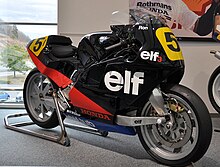Eleven racing machine

Various experimental motorcycles are referred to as the Elf racing machine , which were developed for racing from 1978 to 1988 under the direction of the French Elf Aquitaine group . A feature of all Elf racing motorcycles was a stub axle steering . The French automobile designer André de Cortanze was initially responsible for the development ; Honda later supplied the engines and thus secured the patents .
History and technology
In 1978 de Cortanze presented the Elf-X to the public, a racing motorcycle with kingpin steering and the engine of the Yamaha TZ 750 , which should be superior to other long-distance motorcycles due to its low weight and a low center of gravity as well as the structural separation of the suspension and suspension . Test drives were carried out by Michel Rougerie , a French motorcycle racer.
In 1979, when Honda became aware of the designer, the racing department collaborated with de Cortanze to develop a long-distance racing machine with the engine of the Honda RSC 1000 . This is how the Elf-e came about , the e standing for “Endurance”. In contrast to the Elf-X , all of the following Elf racing machines were built with a single -sided swing arm on the rear wheel. The Elf-e's Honda engine developed 125 hp at 9500 rpm and helped the 173 kg motorcycle to a top speed of over 280 km / h. An aerodynamically optimized offshoot of the Elf-e was developed in 1986 especially for record drives. The Elf-R reached a speed of 321 km / h on September 14, 1986 on the test track in Nardò .
In 1984 the Elf 2 was developed, a 500 cc racing machine, the stub axle steering of which was "revolutionary" controlled by moving the steering handles forwards or backwards. Werner Schwärzel , who drove the Elf 2 on a trial basis, described the racing motorcycle, which was powered by the three-cylinder engine of the Honda NSR 500 and weighed 115 kg, as "not drivable".
"A push start is impossible because you can't hold the motorcycle on the steering that is far too direct, and when you brake, the handlebars position itself shifts."
In 1984 de Cortanze left the project, and Serge Rosset was the successor as head of development. In 1985 the Elf 3 was introduced, which in turn was powered by the Honda three-cylinder engine with 137 hp at 11,400 rpm. In contrast to the Elf 2, the Elf 3 was designed for drivability; with a wheelbase of 1450 mm and a steering head angle of 68 degrees. Ron Haslam was hired as test driver , who was able to lead the ( dry ) 119 kg Elf 3 in the 1986 motorcycle world championship to ninth place overall in the half-liter class. In 1986 Haslam also won the Macau Grand Prix with the Elf 3 .
In the motorcycle world championship season 1987 Haslam achieved fourth overall place in the championship in the class up to 500 cm³ with the Elf 4 (now with a four-cylinder engine ), third places at the Spanish Grand Prix in and at the German Grand Prix were his best results . In addition, he was able to repeat his victory at the Macau Grand Prix last year. The last variant, which in 1988 built Elf 5 , was one of magnesium existing framework reputation as an experimental motorcycle 'needs.
None of the Elf racing machines could achieve the breakthrough. The unusual way of transferring the steering commands to the front wheel led to an unfamiliar change in the driver's driving style. The advantage of the experimental motorcycles due to the optimal separation of the wheel suspension from the suspension became a disadvantage due to the larger unsprung masses. The project was discontinued by Elf in 1988.
"For us, it was primarily just a matter of keeping the name of the company in conversation with future technologies."
| Eleven racing machines | ||||||
| designation | Construction year | Manufacturer (engine) | engine | Displacement | power | |
|---|---|---|---|---|---|---|
| Eleven-X | 1978 | Yamaha | Four cylinder two-stroke engine | 747 cc | 120 hp | [1] |
| Elf-e | 1979-1983 | Honda | Four cylinder four stroke engine | 999 cm³ | 125 hp | [2] |
| Eleven 2 | 1984 | Honda | Three-cylinder two-stroke engine | 499 cc | 120 hp | [3] |
| Eleven 3 | 1985 | Honda | Three-cylinder two-stroke engine | 499 cc | 137 hp | [4] |
| Elf-R | 1986 | Honda | Four cylinder four stroke engine | 999 cm³ | 125 hp | [5] |
| Eleven 4 | 1987 | Honda | Four cylinder two-stroke engine | 499 cc | 140 hp | [6] |
| Eleven 5 | 1988 | Honda | Four cylinder two-stroke engine | 499 cc | 140 hp | [7] |
literature
- Stefan Knittel: ELF racing machines. In: Oldtimer Markt 9/2015., Pp. 92–99.
- Andreas Schulz: Experimental chassis from Europe. In: MOTORRAD Revue 1986/87, pp. 84-100.
Web links
- Alan Cathcart: ELF Racing - ELF Motorcycle Chassis Designs - Retrospectiv. 2009. In: motorcyclistonline.com


